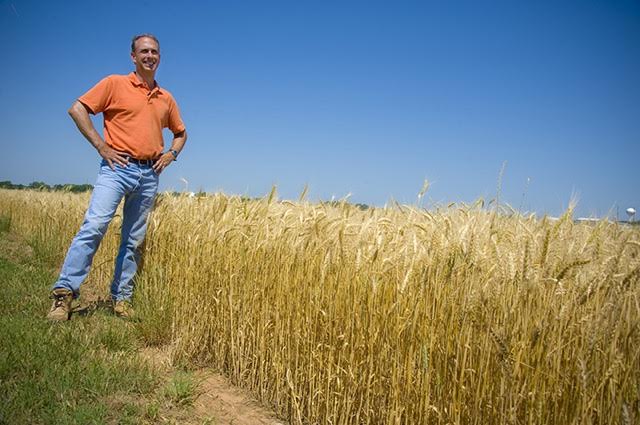
Agricultural News
OSU's Dr. Carver Looks Back at 2015 Wheat Crop, Excited About the Future Prospects
Mon, 24 Aug 2015 17:36:01 CDT
 Mother Nature threw all types of curve balls at the wheat crop this year. The Southern Plains crop experienced both drought conditions along with flooding. In looking back at the 2015 crop, Oklahoma State University Wheat Genetics Chair Dr. Brett Carver said he was very satisfied how the OSU developed wheat varieties handled the conditions.
Mother Nature threw all types of curve balls at the wheat crop this year. The Southern Plains crop experienced both drought conditions along with flooding. In looking back at the 2015 crop, Oklahoma State University Wheat Genetics Chair Dr. Brett Carver said he was very satisfied how the OSU developed wheat varieties handled the conditions.
"We were really hurting for moisture for most of the year and we've had a lot of emphasis put on drought tolerance, you know, in our breeding program, so the varieties we have are fairly good on those conditions," Carver said.
However, no one was quite ready for the monsoon rains that arrived in May. Carver said it's been a long time since they were able to see how the crop would handle heavy rain during the finishing period.
"Some of the varieties didn't do as well as I thought they would have, but then you know this is the first good opportunity we've had since 2007 to look at those kind of conditions," he said.
The other big curveball was the onset of bacterial diseases, which played a big role in the outcome of this year's crop. Carver said unfortunately they don't address bacterial diseases directly.
Mother Nature also threw stripe rust at the crop this year. Carver said he felt like they were prepared for its arrival. He said the strip rust pathogen looked similar to the 2012 pathogen, but was slightly different. Carver said they were seeing injury on varieties that were not badly affected in 2012. Overall, he felt most of the OSU germplasm handed the 2015 stripe rust well.
At the Oklahoma Wheat Review held last week at Redlands Community College in El Reno, Dr. Carver told Radio Oklahoma Ag Network Farm Director Ron Hays about the future of the OSU wheat breeding program. Click or tap on the LISTENBAR below to listen to the full interview.
In looking at future varieties, OSU has been able to speed up advances in developing new varieties with the use of doubled haploid breeding technology. With accelerated breeding, Carver said they are able to produce inbred lines in 16 months instead of seven years. He said they are really speeding up the breeding clock in using this technology. He said they are able to evaluate the grandsons of Duster at the same time they are evaluating the sons of Duster, something they have never been able to do before.
"By making gains quicker you are going to get to the endpoint quicker," Carver said. "The endpoint being higher and higher yields."
In July, OSU announced the release of Bentley, its newest wheat variety. Bentley was named after Walter Dimmitt Bentley, a former educator turned farmer who served as the first director of the Oklahoma Cooperative Extension Service from 1914 to 1916. This variety also honors the cooperative extension service. Carver said Bentley diversifies the OSU genetics in getting away from the Duster line. It also fits well in dual-purpose grazed systems and in minimum-tillage systems promoting the development of multiple leaf spotting diseases.
OSU continues to develop new wheat varieties. Carver thinks OSU's next variety to be released will be a hard, white wheat, with sprouting tolerance and it will be suited for north central Oklahoma. OSU will also continue to improve Clearfield genetic lines. Carver said they are already looking at a new variety that looks to be better than Doublestop, in terms of yield and disease resistance.
WebReadyTM Powered by WireReady® NSI
Top Agricultural News
More Headlines...




















